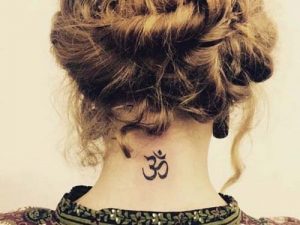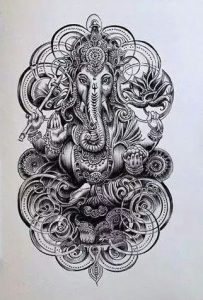Yoga Inspired Tattoos
Yoga has become more accessible than ever due to the past year and studios and teachers taking their offerings online. The practice inspired by a thousands year old philosophy of energy, mind and movement quickly becomes a lifestyle for many. When we identify with any kind of movement or view of life – and we have an interest in tattoos – we tend to want to portray it on our body. Yogis can easily identify one another by the hint of a Sanskrit word on the wrist, an image of the elephant-headed god Ganesha, or chakra symbols along the spine. Let’s take a look at some of the more common yogi-tattoos and see what they mean.
OM
 One of the most recognisable symbols of yogic philosophy is the sign of OM. It is considered the most sacred mantra in Hinduism and Tibetan Buddhism. It appears at the beginning and end of all sacred Sanskrit texts and prayers and represents the whole universe comprised into one single sound. When pronounced it sounds as A-U-M. It is considered the sound of all creation – ‘In the beginning was the Word’.
One of the most recognisable symbols of yogic philosophy is the sign of OM. It is considered the most sacred mantra in Hinduism and Tibetan Buddhism. It appears at the beginning and end of all sacred Sanskrit texts and prayers and represents the whole universe comprised into one single sound. When pronounced it sounds as A-U-M. It is considered the sound of all creation – ‘In the beginning was the Word’.
The physical symbol of OM has curves and lines that represent the five different states of consciousness. The lower left curve stands for the waking state – Jagratha. In the middle, the curved line represents the dream state – Swapna. Top left curve is the deep sleep state known as Sushupti. The line above the larger symbol represents Maya, or the mirage that keeps us from seeing the true reality. If we could see through the illusory veil and awaken to our true nature we would reach Turiya, the transcendent state represented by the dot at the very top.
Ganesha Tattoos
 Ganesha, one of the most well-known Hindu deities, is the god of beginnings. He is also the ruler of obstacles – whether that is through removing them or placing them in our path to send us in a different direction. His elephant head represents wisdom, understanding, and discernment. Meanwhile, his large ears symbolise the willingness to listen in order to attain those things. The little mouse beneath him represents the ego and desire. This is why Ganesha rides the mouse as his Vahana, or vehicle, representing the intellect controlling desire.
Ganesha, one of the most well-known Hindu deities, is the god of beginnings. He is also the ruler of obstacles – whether that is through removing them or placing them in our path to send us in a different direction. His elephant head represents wisdom, understanding, and discernment. Meanwhile, his large ears symbolise the willingness to listen in order to attain those things. The little mouse beneath him represents the ego and desire. This is why Ganesha rides the mouse as his Vahana, or vehicle, representing the intellect controlling desire.
While it may be tempting to ink your love for the yoga practice on your skin, it is best to do your homework on what could potentially be considered cultural appropriation and what symbols and motives actually stand for and represent, and not only have them done because they are aesthetically pleasing.
That being said, yoga and tattooing are both traditions dating back thousands of years, and they marry beautifully – as long as it is done with respect – and Ganesha is pretty chill, so you are unlikely to call down his wrath. However, for example, you may want to opt for a placing higher on the body as opposed to closer to the feet. And think twice about getting a tattoo with the Buddha if you ever want to visit Asia.
